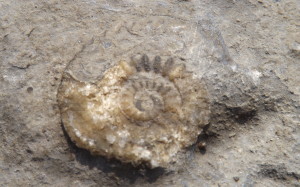In the morning, the street was misty and I worried that it might rain. I don’t know the weather here yet. I haven’t been here long enough to read the patterns as they come. So we packed raincoats along with the sandwiches, the cookies and apples, water bottles and travelling rugs, buckets and shovels and towels, and headed for the beach. Very few things can top a warm October Saturday on the beach.
This was a new beach to us, and all the more wonderful for it. When the scenery is unknown, and the air is simply golden, you find yourself paying more attention to where you are.
(Now I should mention for any fans-of-time-travelling-medics who might be reading this post that the beach in question has featured prominently in a certain sci-fi television program filmed in my current neck of the woods. So, if you like, you can add a pinch of that kind of timelessness to what I am going to say about fossils.)
This was cliff country. Layered cliffs with sandstone and shale towering over wide beaches and a shining sea. The beach was a sandy one, but to reach it, we needed to cross over a broad band of rocks. These were sea-smoothed and grey. Blue called them dragon eggs, and some were as small as his fist, others big as chairs. We sat down on these stones to eat our lunch, watching the tide began to turn and the sands began to emerge. That was when we first noticed the fossils.
Among all the even rocks, a few stood out, marked with paler circles pushing up towards the surface or with darker lines and arcs, scars in stone. Some marks were like open eyes, almond-shaped, elliptic. Bean and I left the picnic remains and walked out along the stones. She took off her shoes, telling me that it was easier to balance with bare feet, of course, and together we stepped from stone to stone, always looking for the next fossil.
Later, when the sea had pulled back far enough, we headed for the rock pools further down the beach, and found that the surrounding rocks were also full of ancient signs of life. Coiled ammonites, belemnite fish shapes, named and unknown, these strange shapes of life.
A landscape like this is an invitation to watch the ground beneath your feet. To pay attention, lean close and wonder. To be surprised. This is good.
It is also a reminder that muck doesn’t last. All these stones were once muck, the silt at the bottom of shallow seas. Those seas ran thick with life and, when creatures died, they settled in the muck. But that muck changed. It solidified and was hardened into smoothness. It became beautiful. Haunting.
But stones don’t last either. Hard things change, too. The cliffs’ layers crumble away, the stones are smoothed right down to sand, these ever-shifting sands under our feet. And despite all this, maybe because of all this, life is beautiful.
I brought this stone home from the beach. It is sitting on the carpet next to my desk, and from time to time, Plum comes down the hallway to climb up and sit down on it, his small fingers tracing the strange shapes on the surface.
O Lord, how manifold are your works! In wisdom you have made them all; the earth is full of your creatures.
Yonder is the sea, great and wide, creeping things innumerable are there, living things both small and great…
I will sing to the Lord as long as I live; I will sing praise to my God while I have being.
May my meditation be pleasing to him, for I rejoice in the Lord.
Psalm 104



